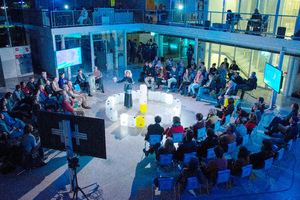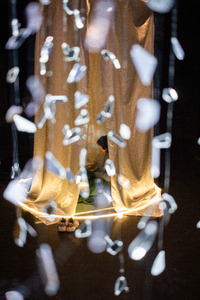Bettina Bessenyei
| Name | Bettina Bessenyei |
2 Inhalte
- Seite 1 von 1
Ministry for the Future
- Titel
- Ministry for the Future
- Titel (en)
- Ministry for the Future
- Autor/in
- Beschreibung (de)
- Ministry for the Future ist eine transdisziplinäre Produktion über mögliche Zukünfte im Angesicht der Klimakrise – und darüber, wie wir sie verhandeln, bevor sie eintreten. Inspiriert vom gleichnamigen Roman von Kim Stanley Robinson entwickelte sich ein groß angelegtes Kooperationsprojekt zwischen dem Theater Neumarkt, dem Collegium Helveticum Zürich und der Hochschule für Gestaltung Karlsruhe.
Ausgangspunkt ist ein spekulatives Szenario im Jahr 2034: Die Erde hat Kipppunkte erreicht, Regierungen reagieren, eine neue Institution wird gegründet – das Ministerium für die Zukunft. Innerhalb dieser Fiktion operiert die Produktion als diskursives Format, das sich fortlaufend mit der zentralen Frage auseinandersetzt: Welche Handlungsspielräume bleiben uns?
Das Projekt kombiniert künstlerische, wissenschaftliche und gestalterische Perspektiven zu einem Format zwischen Preenactment und realer Wissenschaftskommunikation. Herzstück ist ein mobiles Bühnenbild, das drängende forschungsbasierte Diskurse in eine begehbare, funktionale Infrastruktur übersetzt. Die Szenografie wurde konsequent durch Re- und Upcycling-Prozesse entwickelt. Sie folgt einer Haltung, die den Anforderungen ökologischer Krisen standhalten will – indem sie aus dem Material jener Krisen selbst hervorgeht. In vier thematisch fokussierten Episoden an vier verschiedenen Orten in Zürich wird der Raum selbst zum Instrument: eine spekulative Versammlung, eine temporäre Institution, ein Möglichkeitslabor.
Die Inszenierung bringt reale Wissenschaftler:innen, Performer:innen und Bürger:innen im Modus eines fiktionalen Ministeriums in Austausch – und mit ihnen die Fragen: Wie lässt sich Zukunft verhandeln, wenn sie längst begonnen hat? Was bedeutet Teilhabe, wenn die Katastrophe strukturell geworden ist? Und wie kann Raum für solche Aushandlungen heute aussehen?
- Ministry for the Future ist eine transdisziplinäre Produktion über mögliche Zukünfte im Angesicht der Klimakrise – und darüber, wie wir sie verhandeln, bevor sie eintreten. Inspiriert vom gleichnamigen Roman von Kim Stanley Robinson entwickelte sich ein groß angelegtes Kooperationsprojekt zwischen dem Theater Neumarkt, dem Collegium Helveticum Zürich und der Hochschule für Gestaltung Karlsruhe.
- Beschreibung (en)
- Ministry for the Future is a transdisciplinary production about possible futures in the face of the climate crisis—and about how we negotiate them before they arrive. Inspired by the novel of the same name by Kim Stanley Robinson, the project evolved into a large-scale collaboration between Theater Neumarkt, the Collegium Helveticum Zurich, and the Karlsruhe University of Arts and Design (HfG).
Its starting point is a speculative scenario set in the year 2034: the Earth has reached tipping points, governments are reacting, and a new institution is established—the Ministry for the Future. Within this fiction, the production functions as a discursive format that continuously engages with the central question: What room for action remains?
The project combines artistic, scientific, and design perspectives into a hybrid format somewhere between preenactment and real science communication. At its core is a mobile stage design that translates urgent, research-based discourses into an immersive, functional infrastructure. The scenography was developed entirely through re- and upcycling processes, guided by an attitude that seeks to meet the demands of ecological crises—by emerging from their very material. Across four thematically focused episodes in four different locations in Zurich, the space itself becomes an instrument: a speculative assembly, a temporary institution, a lab of possibilities.
The performance brings together real scientists, performers, and citizens within the framework of a fictional ministry—and with them, the questions: How can we negotiate the future when it has already begun? What does participation mean when catastrophe has become structural? And what kind of space is needed for such negotiations today?
- Ministry for the Future is a transdisciplinary production about possible futures in the face of the climate crisis—and about how we negotiate them before they arrive. Inspired by the novel of the same name by Kim Stanley Robinson, the project evolved into a large-scale collaboration between Theater Neumarkt, the Collegium Helveticum Zurich, and the Karlsruhe University of Arts and Design (HfG).
- Kategorie
- Typ des Projekts/Werks
- Schlagworte
- Sprache
- Dauer
- 4 Episoden, jeweils 2 Stunden
- Ort: Institution
- Ort
- Episode 1: ETH Zürich
Episode 2: Naturhistorisches Museum Zürich
Episode 3: Wasserkirche Zürich
Episode 4: Semper Sternwarte / Collegium Helveticum Zürich
- Episode 1: ETH Zürich
- Land
- Beteiligte Institution(en)
- Titel
- Ministry for the Future
- Projektleiter/in
- Semester
- Studiengang
- Importiert am
- 29.06.2025
- Übergeordnete Sets
- 0
- Set enthält
- 0 39
RE: Home
- Titel
- RE: Home
- Titel (en)
- RE: Home
- Autor/in
- Beschreibung (de)
- Wir alle verlassen irgendwann unser erstes Zuhause (das Zuhause unserer Kindheit), entweder freiwillig oder unfreiwillig. Dieser Abschied ist mehr als nur ein physischer Umzug; er markiert den Beginn einer Reise, auf der wir uns ein neues Zuhause schaffen und gleichzeitig die Sehnsucht nach dem Zuhause der Vergangenheit zurücklassen.
Aber Zuhause ist nicht nur der Ort, an dem wir geboren und aufgewachsen sind; es ist auch der Ort (oder Zustand), an dem wir unsere Identität formen, und der psychologische Raum, in dem wir unsere Erinnerungen und Emotionen speichern. Bevor wir weggehen, erinnern wir uns an Zuhause als einen physischen Ort, der uns vertraut und beruhigend ist, aber nachdem wir weggegangen sind, wird es allmählich weniger zu einem konkreten Bild und mehr zu einem fließenden, psychologischen Konzept. Es ist nicht nur ein Verlust, sondern ein Prozess des Findens und Schaffens eines neuen Zuhauses.
In der modernen Welt, in der sich so vieles so schnell verändert, erfinden wir uns ständig neu und das Zuhause ist kein festes Konzept, sondern wird durch die Orte, Erfahrungen und Beziehungen, die wir bewohnen, neu definiert. Heimat ist unser Ausgangspunkt und bleibt nicht unbedingt an einem Ort; vielmehr bewegen und verändern wir uns und entdecken und schaffen auf diesem Weg neue Formen von Heimat.
Was bedeutet also Zuhause für uns und wie schaffen wir es?
- Wir alle verlassen irgendwann unser erstes Zuhause (das Zuhause unserer Kindheit), entweder freiwillig oder unfreiwillig. Dieser Abschied ist mehr als nur ein physischer Umzug; er markiert den Beginn einer Reise, auf der wir uns ein neues Zuhause schaffen und gleichzeitig die Sehnsucht nach dem Zuhause der Vergangenheit zurücklassen.
- Beschreibung (en)
- We all leave our first home (our childhood home) at some point, either willingly or unwillingly. This departure is more than just a physical move; it marks the beginning of a journey where we create a new home, while at the same time leaving behind a sense of nostalgia for the home of our past.
But home isn't just the place where we were born and raised; it's also the place where we form our identity, and the psychological space where we store our memories and emotions. Before we leave, home is remembered as a physical place that is familiar and comforting, but after we leave, it gradually becomes less of a concrete image and more of a fluid, psychological concept. It's not just a loss, but a process of finding and creating a new home.
In the modern world, where so much is changing so quickly, we are constantly re-creating ourselves, and home is not a fixed concept, but is redefined by the places, experiences, and relationships we inhabit. Home functions as our base point, and it doesn't necessarily stay in one place; rather, we move and change, discovering and creating new forms of home along the way.
So, what does home mean to us, and how do we create it?
- We all leave our first home (our childhood home) at some point, either willingly or unwillingly. This departure is more than just a physical move; it marks the beginning of a journey where we create a new home, while at the same time leaving behind a sense of nostalgia for the home of our past.
- Kategorie
- Typ des Projekts/Werks
- Schlagworte
- Mitwirkende
- Material
- Technik/Verfahren/Formate
- Ausstellung
- Abmessungen
- Main : 1 m x 2 m x 2 m (H x B x D), Sub ø 180 cm, H: 2.5 m
- Dauer
- The imaginative narrations take about 10 minutes. / 12.03.2025 - 14.03.2025
- Ort: Institution
- Ort
- Großes Studio
- Stadt
- Land
- Titel
- RE: Home
- Projektleiter/in
- Semester
- Studiengang
- Typ der Abschlussarbeit
- Importiert am
- 10.02.2025
- Übergeordnete Sets
- 2
- Set enthält
- 0 16

